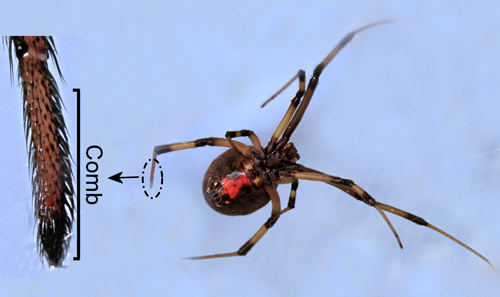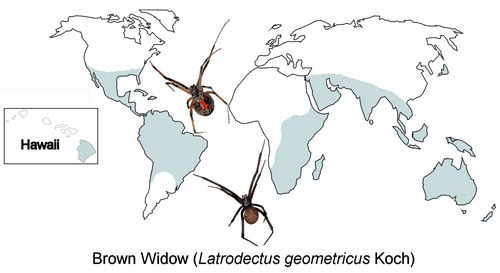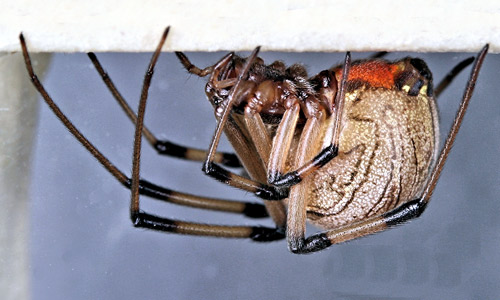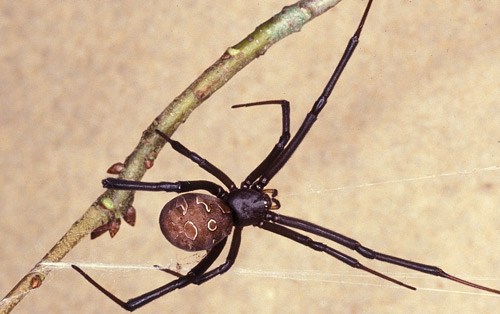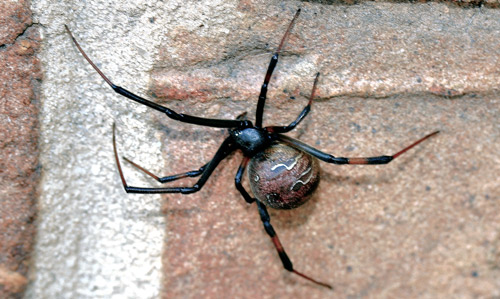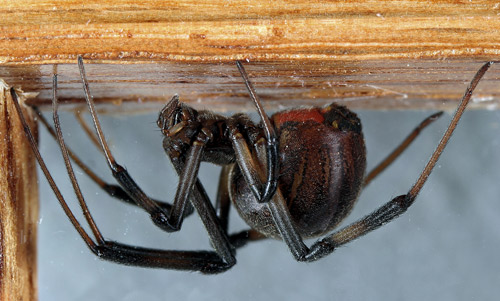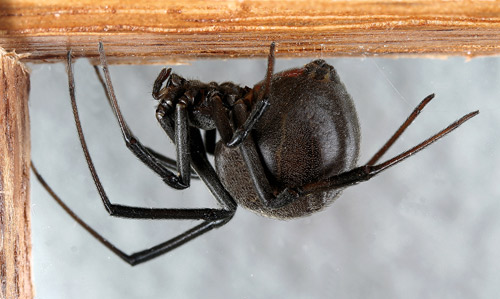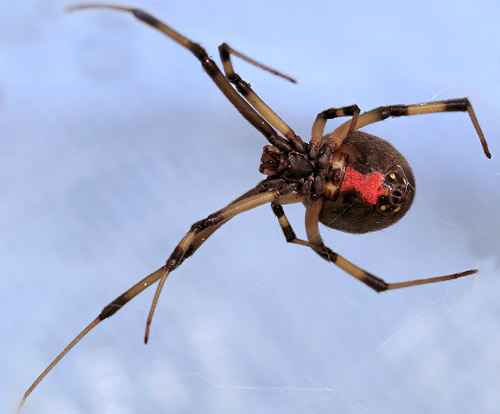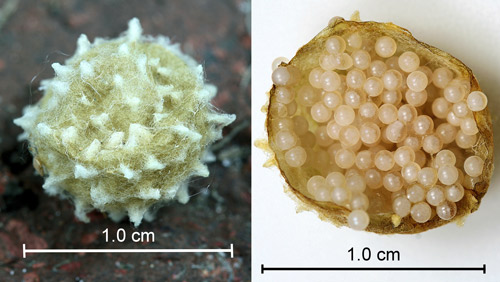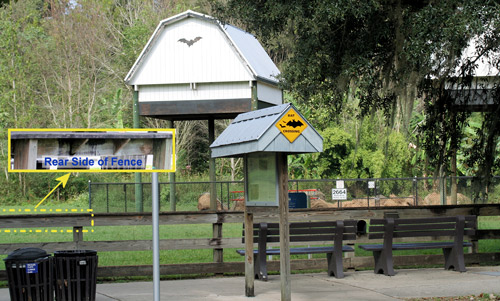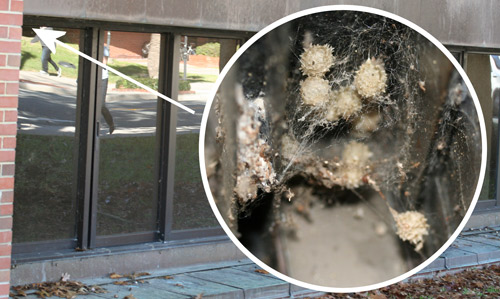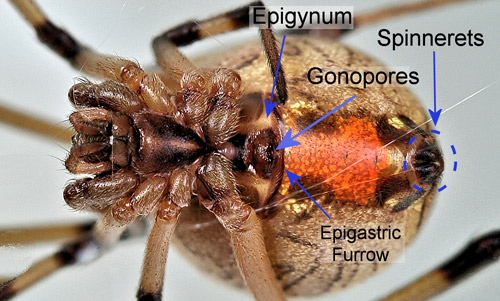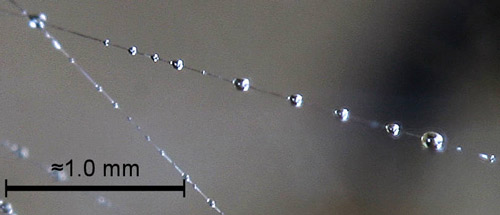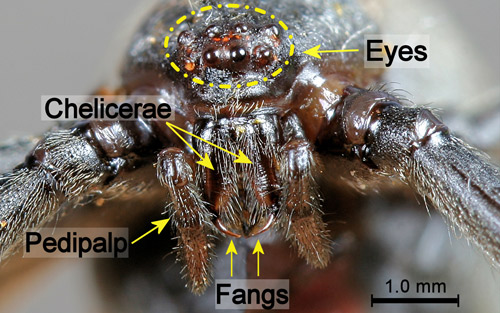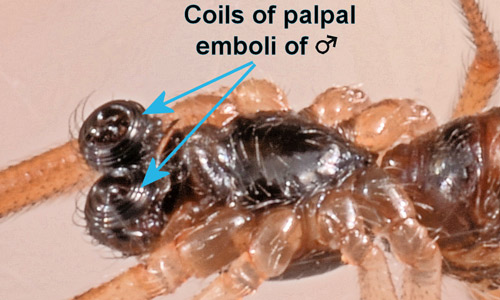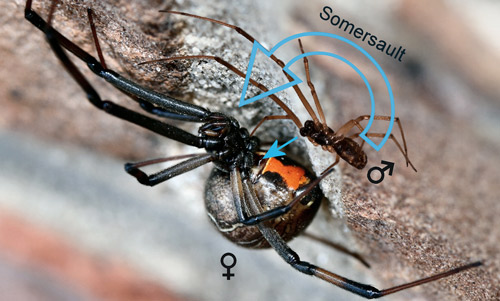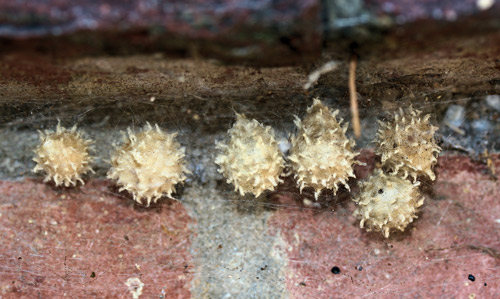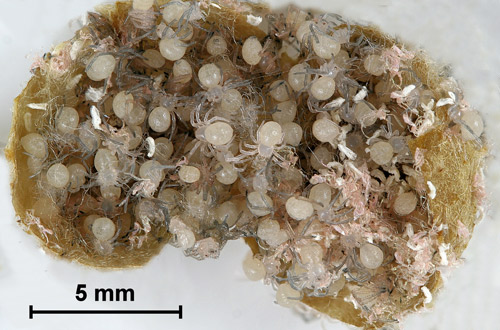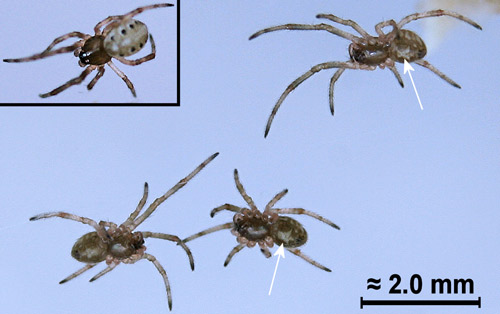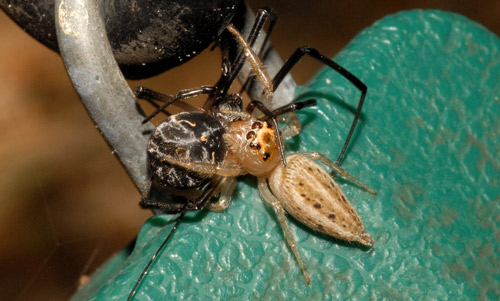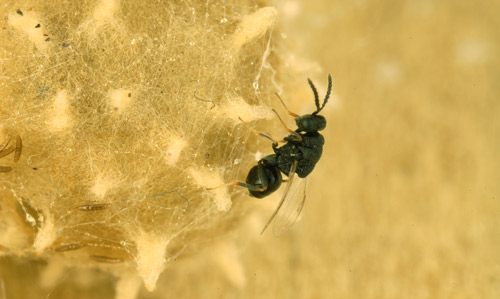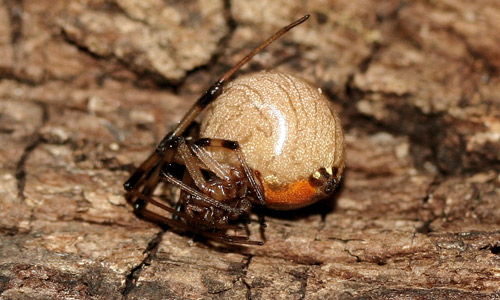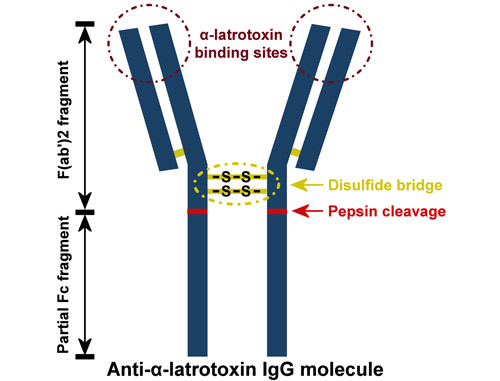common name: brown widow spider
scientific name: Latrodectus geometricus C.L. Koch 1841 (Arachnida: Araneae: Theridiidae)
Introduction - Other Widow Species - Distribution - Description - Biology - Natural Enemies - Medical Importance - Control - Acknowledgements - Selected References
Introduction (Back to Top)
The brown widow spider (Latrodectus geometricus Koch) belongs to the family Theridiidae (Foelix 2011, Howell and Jenkins 2004). Theridiids are known as comb-footed spiders because of the comb-like rows of stout, curved bristles on the tarsi (feet) of the hind pair of legs (Figure 1). They are also known as cobweb spiders because of their irregular webs.
Figure 1. Female brown widow spider, Latrodectus geometricus Koch, tarsal comb. Photograph by Donald W. Hall, Department of Entomology and Nematology, University of Florida.
The genus Latrodectus is composed of two phylogenetic groups - the mactans (black widow) clade and the geometricus (brown widow) clade (Garb et al. 2004).
Brown widows are also sometimes called gray widows (Liu et al. 2009) or brown button spiders (Heeres et al. 1991, Nel et al. 2014). The genus name Latrodectus is from Greek root words meaning “biting in secret” (Cameron 2005, Maretić and Lebez 1979). On a web site on the brown widow (Spiders.us 2016a) it is stated that the name Latrodectus “refers to the painlessness of the initial bite and the fact that it often goes unnoticed until symptoms present”. In one study, 58.2% of 177 patients did not perceive pain immediately at the time of the bite (Maretić 1987). However, the initial effect of the bites of black widows varies from unnoticeable to extremely painful (Balentine 2015, Barron 1960, Blahd and O’Connor 2014). Therefore, it seems equally likely that the name refers to the secretive nature of the spiders and that the victims often do not see what has bitten them.
Other Widow Species (Back to Top)
There are four other species of Latrodectus that occur in the U.S., three of which also occur in Florida:
Latrodectus mactans Fabricius, southern black widow
Latrodectus variolus Walckenaer, northern black widow
Latrodectus bishopi Kaston, red widow
Latrodectus hesperus Chamberlin & Ivie, western black widow (not found in Florida)
Distribution (Back to Top)
The brown widow is believed to be native to southern Africa but was originally described from South America (Vetter 2013). Its distribution is now pantropical and also includes many subtropical areas around the world (Figure 2) (Brown et al. 2008, Muslimin et al. 2015, Suchard 2009). In the U.S., it was originally introduced into southeastern Florida (Pearson 1936, McCrone and Stone 1965). It has now spread northward throughout Florida, into Georgia, North and South Carolina and westward to Alabama, Mississippi, Louisiana, Texas, and also has been introduced into California and Hawaii (Bianchi 1945, Brown et al. 2008, Garb et al. 2004, Suchard 2009). Richman (2013) stated, "The Brown Widow, Latrodectus geometricus Koch, has recently been reported in Arizona and is expected to invade New Mexico eventually, if it has not already". Therefore, New Mexico was included in the distribution map below (Figure 2). The brown widow will likely continue to extend its range both in the U.S. and abroad into areas where environmental conditions are suitable.
Figure 2. Brown widow spider, Latrodectus geometricus, distribution map. Map by Donald W. Hall, Department of Entomology and Nematology, University of Florida.
Barcoding (DNA sequencing of the gene for mitochondrial cytochrome oxidase subunit I) of brown widow specimens from around the world shows minimal genetic divergence. This supports the hypothesis that the expansion of the brown widow’s distribution around the world is relatively recent and is likely the result of human activities (Garb et al. 2004). There is some evidence of competitive displacement of black widows following introduction of brown widows into an area (Bianchi 1945, Vetter et al. 2012a).
Description (Back to Top)
Adults: Males (body length 2-4 mm) are much smaller than females (body length 7-10 mm) (Benjamin and Zschokke 2003, Edwards and Marshall 2002). Females are highly variable in pattern and color - they can be almost white, gray, light brown, dark brown or almost black (Edwards 2002, Heeres 1991, Müller 1993b) (Figures 3-7). Apparently, the color is determined by the color of the substrate and can change at the time of molting if the substrate color has changed (Lamoral 1968). The spider in Figure 3 below was collected on a white mortar background, the one in Figure 5 on a red brick background, and those in Figures 6 and 7 were collected on the dark-colored background on the underside of the top board of a wooden fence.
The abdomens of brown widow females are covered with fine silky hairs of two lengths (Smithers 1944). Lighter colored individuals often have one dorsal and three lateral bands or splotches on the abdomen – all outlined with darker lines (Figures 4 and 5). In dark individuals, the pattern is often nearly obscured (Figure 7) unless viewed in exceptionally bright light.
Figure 3. Female brown widow spider, Latrodectus geometricus Koch (nearly white coloration). Photograph by Donald W. Hall, Department of Entomology and Nematology, University of Florida.
Figure 4. Female brown widow spider, Latrodectus geometricus Koch (tan coloration). Photograph by James L. Castner, Department of Entomology and Nematology, University of Florida.
Figure 5. Female brown widow spider, Latrodectus geometricus Koch (brick-red coloration). Photograph by Donald W. Hall, , University of Florida.
Figure 6. Female brown widow spider, Latrodectus geometricus Koch (dark brown coloration). Photograph by Donald W. Hall, Department of Entomology and Nematology, University of Florida.
Figure 7. Female brown widow spider, Latrodectus geometricus Koch (nearly black coloration). Photograph by Donald W. Hall, Department of Entomology and Nematology, University of Florida.
Identification: Dark specimens resemble black widows. However, the hourglass of the brown widow is yellowish-orange or reddish-orange (Figure 8) instead of bright red as in the black widow. Also, the legs of black widows are solid black whereas at least some banding or lighter coloration is usually visible on the legs of even the darkest colored brown widows (Figure 7).
Figure 8. Female brown widow spider, Latrodectus geometricus Koch, ventral view. Note reddish-orange hourglass. Photograph by Donald W. Hall, Department of Entomology and Nematology, University of Florida.
Egg sacs: Egg sacs measure approximately one centimeter in diameter. New sacs are white (Figure 9) but become yellow/tan with age. After hatching of the young, the egg sacs appear dark gray due to the mass of spiderlings that show through the walls (Smithers 1944). Brown widow egg sacs are unique because of the white silk spikes on the surface which are not present on egg sacs of any other Latrodectus species (Abalos 1962). In fact, I have been unable to find evidence in the literature of egg sacs of any other spider species that bear these spikes.
Figure 9. Relatively new egg sac of brown widow spider, Latrodectus geometricus Koch (left), opened to show eggs (right). Photographs by Donald W. Hall, Department of Entomology and Nematology, University of Florida.
The eggs are approximately 0.1 mm in diameter (Figure 9).
Biology (Back to Top)
Habitat: Brown widows thrive in peridomestic habitats (Almeida et al. 2009, Edwards 2002, Smithers 1944, Vetter 2013) - e.g., under eaves of buildings, ledges of brick walls or top boards of wooden fences (Figure 10), under picnic tables, and among debris - often in well-lighted areas (McCrone and Stone 1965) and also in hollow trees and under loose bark. They tend to be found in more open areas than black widows (Vetter 2013). They are common on the University of Florida campus (Bibbs et al. 2013), and I have observed them at the football stadium, in the elevator shaft of the UF Health-Shands Hospital parking garage, and on campus buildings - where they are particularly common in the upper corners of windows (Figure 11).
Figure 10. Wooden fence and information case that harbor large numbers of brown widow spiders (Latrodectus geometricus Koch) and their egg sacs under the top board and roof, respectively. Photograph by Donald W. Hall, Department of Entomology and Nematology, University of Florida.
Figure 11. Windows of Marston Science Library (University of Florida) with numerous egg sacs (inset) of brown widow spiders (Latrodectus geometricus Koch). Photograph by Donald W. Hall, Department of Entomology and Nematology, University of Florida.
Probably the most unusual brown widow habitat described in the scientific literature was ocean beaches in Brazil (Anderson 1972) where webs were spun among beach morning glories (Ipomoea biloba Forssk, current name: Ipomoea pes-caprae [L.] R.Br.).
Webs and Prey Capture: Silk for the webs is spun by spinnerets at the tip of the abdomen. There are six spinnerets, but the median pair are hidden by the other four (Levi 2005) (Figure 12). The webs are irregular with a peripheral retreat where the female seeks shelter when she is threatened. For a detailed description of the construction and structure of the webs, see Benjamin and Zschokke (2003). Capture threads are coated with sticky droplets (Figure 13). After prey become entangled in the sticky web, the spider immobilizes the prey by casting sticky silk (drawn out with the combs on the hind leg tarsi) on the prey. After the prey is immobilized, the spider bites (Figure 14) and injects the prey with venom (Howell and Jenkins 2004).
Figure 12. Ventral view of female brown widow spider, Latrodectus geometricus Koch, showing spinnerets, epigynum, and epigastric furrow. Photograph by Donald W. Hall, Department of Entomology and Nematology, University of Florida.
Figure 13. Capture threads of silk of brown widow spider, Latrodectus geometricus Koch, with sticky droplets. Photograph by Donald W. Hall, Department of Entomology and Nematology, University of Florida.
Figure 14. Female brown widow spider, Latrodectus geometricus Koch, biting prey. Photograph by Donald W. Hall, Department of Entomology and Nematology, University of Florida.
Courtship and Mating: Female sex pheromones have been demonstrated on the webs of black widows and Australian redback widows, Latrodectus hasselti Thorell, (Baruffaldi and Andrade 2015). Ross and Smith (1979) reported the presence of both male and female sex pheromones on webs of western black widows. The pheromones may function in mate recognition. Also, well-fed females produce more silk and pheromone - possibly resulting in sexual selection by males for more fecund females (Baruffaldi and Andrade 2015). Sex pheromones have not yet been documented in other Latrodectus species.
Female pedipalps are leg-like (Figure 15) and are primarily tactile in function. The pedipalps of males are enlarged and function in sexual signaling and copulation. Prior to mating, the male spins a small sperm web on which he deposits a drop of sperm. The sperm are then sucked up through coiled, tube-like emboli (Figure 16) into the bulbs of the male’s pedipalps (Foelix 2011, Abalos and Baez 1963 [diagram of embolus]).
Figure 15. Front of female brown widow spider, Latrodectus geometricus Koch, cephalothorax showing pedipalps, chelicerae, fangs and eyes. Photograph by Donald W. Hall, Department of Entomology and Nematology, University of Florida.
Figure 16. Male brown widow spider, Latrodectus geometricus Koch, showing coiled emboli in the palps. Image cropped from photograph by Lyle J. Buss, Department of Entomology and Nematology, University of Florida.
The following account of courtship behavior and copulation is given by Abalos and Baez (1963), Benamú (2001), and Segoli et al. (2008). The male begins by plucking the threads of the female’s web with his tarsi and waving his enlarged pedipalps to attract the female’s attention. These behaviors may be repeated several times. Next, he restrains the first and fourth pairs of legs of the female with silk. Copulation is accomplished by the alternate insertion of the embolus of first one palpus and then the other into the female gonopores, which are located on the female epigynum. The female epigynum consists of an external sclerite (Figure 12) to which the internal seminal receptacles are connected (Gordh and Headrick 2001, Levi 1961) (see scanning electron micrograph at Spiders.us [2016b]). Once the emboli are inserted into the seminal receptacles, their apical elements (tips) are broken off and the semen is injected. The apical elements remain in the seminal receptacles but apparently do not act as mating plugs to prevent multiple matings (Abalos and Baez 1963).
Female widow spiders of most species rarely kill their mates (Benamú 2001, Bettini and Maroli 1978). However, Segoli et al. (2008) have shown that this behavior is common in brown widows. After inserting the embolus of a palp into the female’s gonopore, the male brown widow often somersaults (Figure 17) into a position where the apical portion of his abdomen is in front of the female’s chelicerae, and he may then be attacked. The female may kill the male and sometimes also wraps him in silk. She may or may not eat him. This stereotyped sexual sacrifice behavior by the male was previously documented for the Australian redback widow spider (Andrade 1996, Forster 1992) and also probably occurs in Latrodectus indistinctus Pickard-Cambridge (Smithers 1944).
Figure 17. Diagrammatic combined photos of male and female brown widow spiders, Latrodectus geometricus Koch, to illustrate male somersault behavior. Photograph of female by Donald W. Hall, Department of Entomology and Nematology, University of Florida plus digitally pasted image of male from photograph by Lyle J. Buss, Department of Entomology and Nematology, University of Florida.
Oviposition: Eggs are laid through the oviduct which opens at the midline of the epigastric furrow (Levi 1961) (Figure 12). Egg sacs are almost always constructed at night (Heeres 1991). A female clusters her egg sacs together in the same web (Figure 18). Bouillon et al. (1961) reported that with adequate nutrition, inseminated females laid an average of 23 egg sacs under laboratory conditions. Two hundred fourteen wild-collected egg sacs from southern California dissected by Danielson et al. (2014), averaged 129±51 eggs/sac.
Figure 18. Cluster of brown widow spider, Latrodectus geometricus Koch, egg sacs. Photograph by Donald W. Hall, Department of Entomology and Nematology, University of Florida.
Hatching and Development: Spiderlings hatch from eggs in 14-21 days but remain in the egg sac for a few days to a month (Reid et al. 2003). Newly hatched spiderlings are pale, without patterns (Figure 19). The spiderlings then molt and develop patterns (including the hourglass) before leaving the egg sac, but initially the hourglass is white instead of orange (Figure 20).
Figure 19. Recently-hatched brown widow, Latrodectus geometricus Koch, spiderlings (in 20-day-old egg sac) that have not yet developed patterns. Photograph by Donald W. Hall, Department of Entomology and Nematology, University of Florida.
Figure 20. Ventral view of brown widow, Latrodectus geometricus Koch, spiderlings (from opened egg sac) that have developed patterns. Note white hourglass pattern (arrows). Inset = dorsal view of spiderling. Photographs by Donald W. Hall, Department of Entomology and Nematology, University of Florida.
After leaving the egg sac, the spiderlings remain aggregated in the area for a period of time leading to some cannibalism which may increase the probability that some will survive (Guimarães et al. 2012). Eventually, the spiderlings disperse by a behavior known as ballooning, which involves releasing strands of silk which are caught by updrafts of wind causing the spiderlings to become airborne (Baerg 1959, Decae 1986). Spiders can be dispersed for many miles by ballooning. An unidentified theridiid was captured at an altitude of 2,000 feet, and species of other spider families have been captured at altitudes as high as 3,000 feet (Glick 1960). Spiders of some species balloon for great distances and have been observed on ships far out to sea (Cushing 2005).
Females molt 6 to 9 times and males 3 to 6 times before reaching maturity (Reid et al. 2003, Vetter 2013). Benamú (2001) reported average times to reach sexual maturity of 37 days for males and 96 days for females and average lifetimes of 108 days for males and 519 days for females.
Natural Enemies (Back to Top)
Birds and lizards are probably the primary vertebrate predators of widow spiders (Baerg 1959, Maretić 1978). Because of the sheltered sites where they spin their webs, brown widows may escape detection by some potential vertebrate predators.
Invertebrates are likely important predators of widow spiders. In addition to generalist invertebrate predators (e.g., other spiders [Figure 21] and possibly predatory Hemiptera and Coleoptera), many are attacked by mud dauber wasps (Hymenoptera: Sphecidae).
Figure 21. Jumping spider, Colonus sylvanus (Hentz) (Salticidae) with brown widow, Latrodectus geometricus Koch, prey. Photograph by Lyle J. Buss, Department of Entomology and Nematology, University of Florida.
The shiny blue mud daubers in the genus Chalybion are major predators of black widow spiders and may even be widow specialists (Baerg 1959, Dean et al. 1988, Horner and Klein 1979, Irving and Hinman 1935, Muma and Jeffers 1945, Nel et al. 2014, Rau 1935). In South Africa, Chalybion spinolae Lepeletier de Saint Fargeau is reported to provision its nests exclusively with Latrodectus species (Nel et al. 2014).
Chalybion species do not construct their own nests. They steal the sealed nests of other mud daubers (particularly those of Sceliphron caementarium (Drury) in the U.S.) by opening the cells of the previous owner and removing the original spider prey and mud dauber eggs or larvae (Rau 1928). They then re-provision the nests with their own prey and eggs. Although Baerg (1959) reported black widows from the nest cells of Sceliphron caementarium, it is possible that these were actually the prey of Chalybion mud daubers that had taken over the Sceliphron nests.
There are at least five species of parasitoids/predators reported from brown widow egg sacs:
| Egg Sac Parasitoids/Predators | References |
| Philolema (formerly Eurytoma) arachnovora (Hesse) (Hymenoptera: Eurytomidae) | Baerg (1959) |
| Philolema latrodecti Fulloway (Hymenoptera: Eurytomidae) (Figure 22) | Bibbs and Buss (2011) |
| Brambila and Evans (2001) | |
| Pediobius pyrgo (Walker) (Hymenoptera: Eulophidae) | Schoeninger et al. (2015) |
| Pseudogaurax signatus (Loew) (Diptera: Chloropidae) | Vetter et al. (2012b) |
| Afromantispa tenella (Erichson) formerly Mantispa tenella [Erichson] (Neuroptera: Mantispidae) (See Catalog of Life 2015) | Mackay (1972) from Rhodesia (currently Zambia and Zimbabwe) |
Figure 22. Philolema lactrodecti Fulloway (Hymenoptera: Eurytomidae) parasitoid on brown widow spider (Latrodectus geometricus Koch) egg sac. Photograph by Lyle J. Buss, Department of Entomology and Nematology, University of Florida.
Vetter et al. (2012b) examined 3,739 brown widow egg sacs in southern California and observed many small arthropods entangled on the surfaces of the sacs. They speculated that the spiked surface of the egg sacs may serve as a barrier to parasitoids.
At least two microorganisms have been reported to infect brown widows. Arrington (2014) reported variable infection rates (20-90%) in different populations with Wolbachia pipientis Hertig and Wolbach. However, the Wolbachia infections did not appear to affect development or reproduction. Bibbs et al. (2013) isolated a strain of the fungus Mucor fragilis Bainier from brown widow females from north central Florida. In laboratory bioassays, the fungus produced 83% mortality rates.
Medical Importance (Back to Top)
Symptoms of many other medical conditions can and have been mistaken for spider bites. Vetter and Isbister (2008) provided a detailed discussion on criteria for incrimination of spiders as the cause of medical conditions.
Only female brown widows are capable of biting vertebrates. The chelicerae and fangs of the males are too small to bite vertebrates (Bettini and Maroli 1978). Those of the female are larger (Figure 15) and the fangs are able to penetrate vertebrate skin by working in a horizontal pinching motion. The venom is injected through the hollow tips of the fangs.
Female brown widows are not aggressive and will usually withdraw to their retreats rather than attack when their web is disturbed (Goddard et al. 2008). If the retreat area of the web is disturbed, the spiders usually drop to the ground, retract their legs, and feign death (Figure 23) (a behavior known as thanatosis) (Muslimin et al. 2015, DW Hall personal observation). This behavior not only helps them escape predators but also reduces the likelihood of them biting humans. Most bites occur when the spiders are accidently trapped against the skin. Therefore, brown widow bites are not common considering the relatively large numbers of spiders present in some areas.
Figure 23. Female brown widow spider, Latrodectus geometricus Koch, feigning death (thanatosis) with legs folded against the body. Photograph by Donald W. Hall, Department of Entomology and Nematology, University of Florida.
Symptoms: Black widow bites to humans may result in a variety of systemic symptoms (Sampayo 1943 and 1944). Typically, brown widow bites are not as serious as those of the black widow, and pain is usually restricted to the area immediately adjacent to the bite wound (Almeida et al. 2009, Foelix 2011, Suchard 2009). Also, approximately 15% of bites may be “dry” with no venom injected (Reyes-Lugo et al. 2009). However, some bites do cause the more severe, systemic symptoms characteristic of black widows (Arnold and Ryan 2009, Goddard et al. 2008, Müller 1993a).
Müller (1993a) reported the incidence of the following systemic symptoms from 15 cases of brown widow bites in South Africa: generalized muscle pain and cramps (2), abdominal pain and cramps (4), weakness in legs and difficulty in walking (2), pain in regional lymph nodes (2), and raised temperature (2).
Venom: Like the venoms of other widow spiders (genus Latrodectus), brown widow venom is toxic to vertebrates, but is generally considered to be less toxic than that of other widow spiders (Garb and Hayashi 2013, Guimarães et al. 2012, Heeres 1991, Müller et al. 1989, Müller 1993a, Sampayo 1943). The relative toxicity of the widow spiders may depend on the species of animal. For example, Sampayo (1943) stated that brown widow venom is much less toxic to guinea pigs than is black widow venom. However, McCrone (1964) reported that brown widow venom is more toxic than black widow venom in mice, and Guerrero et al. (2010) stated that based on their studies with mice, brown widow venom appears to be one of the most toxic Latrodectus venoms. An important factor in cases of human envenomation is that brown widows inject smaller quantities of venom than other Latrodectus species (Goddard et al. 2008, McCrone 1964). This may be due to the smaller size of their venom glands (Maretić and Lebez 1979).
The major active component of Latrodectus venom is α-latrotoxin - a potent vertebrate neurotoxin (Garb and Hyashi 2013). A major effect of α-latrotoxin is the formation of cation pores in the membranes of nerve terminals resulting in an influx of calcium and concomitant depolarization of the membranes with uncontrolled release of neurotransmitters, especially acetylcholine and norepinephrine (Yan and Wang 2015), at synapses (Holz and Habener 1998, Orlova et al. 2000, Reyes-Lugo et al. 2009, Saibil 2000). The resulting neurotransmitter binding at postsynaptic receptors of various neuronal systems induces the muscle spasms, pain, and other symptoms associated with the clinical “latrodectism” syndrome (Luch 2010, Maretić 1987). Guerrero et al. (2010) found that brown widow venom also damages the cortex of the adrenal glands resulting in acute adrenal insufficiency in mice. The adrenal glands produce a number of hormones and other chemicals including estrogen, progesterone, steroids, cortisol and cortisone, epinephrine, norepinephrine, and dopamine (Wisse and Zieve 2015).
Treatment: Initial treatment for widow spider bites usually involves pain management with opioids and administration of benzodiazepines for muscle spasms (Arnold and Ryan 2009, Monte 2012, Bassanou et al. 2015). Calcium gluconate is no longer recommended (Bush and Alcock 2015).
More severe cases with symptoms of longer duration may be treated with antivenin. The α-latrotoxins of Latrodectus species are similar (McCrone and Netzloff 1965, Garb and Hyashi 2013), and antivenin to one is likely to be effective in treatment of bites of other widow species (Jelinek 1997). Arnold and Ryan (2009) stated that black widow antivenin is effective in treatment of brown widow bites.
A major concern in the use of antivenin is allergic reactions because the antivenins are made in animals (usually horses in the U.S. and sheep in Australia). The black widow antivenin currently available in the United States is composed of whole immunoglobulins and is prepared in horses against the venom of Latrodectus mactans (Merck 2015). Reported adverse effects from the use of antivenin in the U.S. are relatively rare (Monte et al. 2011). Although antivenin has been used in Australia for treatment of Australian redback widow bites for many years, its efficacy is still debatable (Bush and Alcock 2015).
A new black widow antivenin (Analatro®) made with purified F(ab')2 antibody fragments has recently undergone stage 3 clinical trials (ClinicalTrials.gov 2015). The F(ab')2 fragment is the part of an immunoglobulin G (IgG) antibody molecule that contains the two binding sites for the antigen (α-latrotoxin in the case of widow spider antivenin) after cleavage from most of the Fc fragment by enzymatic digestion with pepsin (Figure 24). Removal of the Fc fragment and purification of the F(ab')2 antibody fragments may reduce the risk of adverse reactions related to use of whole antibody antivenin (Monte 2012, Nimmerjahn and Ravetch 2008, Theakston and Lalloo 2001).
Figure 24. Diagram of anti α-latrotoxin immunoglobulin G (IgG) antibody molecule illustrating pepsin digestion to prepare F(ab')2 fragment. Diagram by Donald W. Hall, Department of Entomology and Nematology, University of Florida.
Medical information in this article is for educational purposes only. It is not intended to replace medical advice offered by physicians.
Control (Back to Top)
Where control is required, commercially available insecticides should be effective (Koehler and Andrews 2015, Vetter 2013). Insecticidal sprays or dusts should be applied to cracks and crevices where the spiders may take refuge. Also, reducing clutter around the house and in garages and storage areas should aid in reducing populations.
Acknowledgements (Back to Top)
The author would like to acknowledge Lisa A. Taylor and Glavis B. Edwards for reviewing this article and offering helpful suggestions.
Selected References (Back to Top)
- Abalos JW. 1962. The egg-sac in the identification of species of Latrodectus (black-widow spiders). Psyche 69(4): 268-270.
- Abalos JW, Baez EC. 1963. On spermatic transmission in spiders. Psyche 70: 197-207.
- Almeida RAMB, Ferreira RS, Chaves CR, Barraviera B. 2009. Envenomation caused by Latrodectcus geometricus in Sao Paulo State, Brazil: a case report. Journal of Venomous Animals and Toxins Including Tropical Diseases 15: 562-571.
- Anderson MP. 1972. Notes on the brown widow spider Latrodectus geometricus (Araneae: Theridiidae) in Brazil. Great Lakes Entomologist 5: 115-118.
- Andrade MCB. 1996. Sexual selection for male sacrifice in the Australian redback spider. Science 271: 70-72.
- Arnold TC, Ryan ML. 2009. Just when you thought it was safe: the brown widow spider (Latrodectus geometricus) makes her presence known on the Gulf Coast. Clinical Toxicology 47: 738. Meeting Abstract: 176.
- Arrington, BD. 2014. The Prevalence and Effect of Wolbachia Infection on the Brown Widow Spider (Latrodectus geometricus) Georgia Southern University. Statesboro, Georgia. USA. Electronic Theses & Dissertations. Paper 1113. (11 February 2016)
- Baerg WJ. 1959. The black widow and five other venomous spiders in the United States. Agricultural Experiment Station, University of Arkansas. Fayetteville, Arkansas. Bulletin 608. 43 pp.
- Balentine JR. 2015. Black widow spider bite symptoms. http://www.emedicinehealth.com/black_widow_spider_bite/page2_em.htm (11 February 2016)
- Barron WE. 1960. Spider bites. Journal of the Medical Association of Georgia 49: 511-512.
- Baruffaldi L, Andrade MCB. 2015. Contact pheromones mediate male preference in black widow spiders: avoidance of hungry sexual cannibals? Animal Behaviour 102: 25-32.
- Basanou E, Kalostou A, Sofidiotou V, Fountas K, Kalantzopoulos D, Papathanassiou V, Neou P. 2015. Treatment of black widow spider (Latrodectus mactans) envenomation: a review of 53 cases. Clinical Toxicology 53: 281 (Meeting abstract of the XXXV International Congress of The European Association of Poisons Centres and Clinical Toxicologists.
- Benamú MA. 2001. Comportamiento reproductivo de Latrodectus geometricus C.L. Koch, 1841 (Araneae: Theridiidae). Revista Peruana de Entomologia 42: 89-91.
- Benjamin SP, Zschokke S. 2003. Webs of theridiid spiders: construction, structure and evolution. Biological Journal of the Linnean Society 78: 293-305.
- Bettini S, Maroli M. 1978. A. Venoms of Theridiidae, genus Latrodectus. Chap. 8. pp 149-185. In Bettini S, ed., Arthropod Venoms. Vol 48. Handbook of Experimental Pharmacology. Springer-Verlag. Berlin, Germany. 977 pp.
- Bianchi FA. 1945. Notes on the abundance of the spiders Latrodectus mactans, L. geometricus, and Argiope avara, and of their parasites on the island of Hawaii. Proceedings of the Hawaiian Entomological Society 12: 245-247.
- Bibbs CS, Buss LJ. 2011. Widow spider parasitoids. http://entnemdept.ufl.edu/creatures/beneficial/wasps/latrodectus_parasitoids.htm (11 February 2016)
- Bibbs CS, Vitoreli AM, Benny G, Harman CL, Baldwin RW. 2013. Susceptibility of Latrodectus geometricus (Araneae: Theridiidae) to a Mucor strain discovered in North Central Florida, USA. Florida Entomologist 96: 1052-1061.
- Blahd WH, O’Connor M. 2014. Black Widow Spider Bite Guide. http://www.webmd.com/first-aid/tc/black-widow-spider-bite-topic-overview (Accessed February 11, 2016)
- Bouillon A, Lekie R, Koch R. 1961. Cycle and rhythm in the ovulation of the spider Latrodectus geometricus. Nature 191: 620-621.
- Brambila J, Evans GA. 2001. Hymenopteran parasitoids associated with spiders in Florida. Insecta Mundi 15: 18.
- Brown KS, Necaise JS, Goddard J. 2008. Additions to the known distribution of Latrodectus geometricus (Araneae: Theridiidae). Journal of Medical Entomology 54: 959-962.
- Bush SP, Alcock J. 2015. Widow spider envenomation medication. http://emedicine.medscape.com/article/772196-medication (11 February 2016)
- Cameron HD. 2005. An etymological dictionary of North American spider genus names. Chap. 73, p. 301. In Ubick D, Paquin P, Cushing PE, Roth V. eds. Spiders of North America: an identification manual. American Arachnological Society. Keene, New Hampshire. 377 pp.
- Catalog of Life. 2015. Infraspecific taxon details: Afromantispa tenella tenella (Erichson, 1839). http://www.catalogueoflife.org/col/details/species/id/66394a23725ee19a3ee6e6f2c94c8322 (11 February 2016)
- ClinicalTrials.gov. 2015. https://clinicaltrials.gov/ct2/show/NCT00657540 (11 February 2016)
- Cushing PE. 2005. Introduction. p. 13. In Ubick D, Paquin P, Cushing PE, Roth V. eds. Spiders of North America: an identification manual. American Arachnological Society. Keene, New Hampshire. 377 pp.
- Danielson DWR, Clarke DE, Valle SJ, Anselmo AA, Vincent LS. 2014. Natural egg sac clutch size of the brown widow spider, Latrodectus geometricus (Araneae: Theridiidae) in southern California. Bulletin of the Southern California Academy of Sciences 113: 100-102.
- Dean DA, Nyffeler M, Sterling WL. 1988. Natural enemies of spiders: mud dauber wasps in East Texas. The Southwestern Entomologist 13: 283-290.
- Decae AE. 1987. Dispersal: Ballooning and other mechanisms. pp. 348-356. In Nentwig W. ed. Ecophysiology of Spiders. Springer-Verlag. New York. 448 pp.
- Edwards GB. (2002). Venomous Spiders in Florida. Pest Alert. Florida Department of Agriculture and Consumer Services, Division of Plant Industry. (11 February 2016)
- Edwards GB, Marshall S. 2002. Florida’s Fabulous Spiders. World Publications. Tampa, Florida. 64 pp.
- Foelix RF. 2011. Biology of Spiders. Oxford University Press. New York. 419 pp.
- Forster LM. 1992. The stereotyped behavior of sexual cannibalism in Latrodectus hasselti Thorell (Araneae, Theridiidae), the Australian redback spider. Australian Journal of Zoology 40: 1-11.
- Garb JE, González A, Gillespie RG. 2004. The black widow spider genus Latrodectus (Araneae: Theridiidae): phylogeny, biogeography, and invasion history. Molecular Phylogenetics and Evolution 31: 1127-1142.
- Garb JE, Hayashi CY. 2013. Molecular evolution of alpha-latrotoxin, the exceptionally potent vertebrate neurotoxin in black widow spider venom. Molecular Biology and Evolution 30: 999-1014.
- Glick PA. 1960. Collecting insects by airplane, with special reference to dispersal of the potato leafhopper. U.S. Department of Agriculture Technical Bulletin Number 1222. 16 pp.
- Goddard J, Upshaw S, Held D, Johnnson K. 2008. Severe reaction from envenomation by the brown widow spider, Latrodectus geometricus (Araneae: Theridiidae). Southern Medical Journal 101: 1269-1270.
- Gordh G, Headrick DH. 2001. A Dictionary of Entomology. CABI Publishing. New York. 1032 pp.
- Guerrero B, Finol HJ, Reyes-Lugo M, Salazar AM, Sánchez EE, Estrella A, Roschman-González, Ibarra C, Salvi I, Rodríguez-Acosta. 2010. Activities against hemostatic proteins and adrenal gland ultrastructural changes caused by the brown widow spider Latrodectus geometricus (Araneae: Theridiidae) venom. Comparative Biochemistry and Physiology. Part C. 151: 113-121.
- Guimarães I de C, da Silva HM, Antonialli WF, Jr. 2012. Aggregation behavior in spiderlings: a strategy for increasing life expectancy in Latrodectus geometricus (Araneae: Theridiidae). Sociobiology 59: 463-476.
- Heeres A. 1991. Natural history observations of the brown widow spider Latrodectus geometricus (Araneae: Theridiidae). Naturalist (Port Elizabeth) 35: 31-34.
- Holz GG, Habener JF. 1998. Black widow spider alpha-latrotoxin: A presynaptic neurotoxin that shares structural homology with the glucagon-like peptide-1 family of insulin secretagogic hormones. Comparative Biochemistry and Physiology. Part B. 121: 177-184.
- Horner NV, Klein JH. 1979. Spider prey of two mud dauber wasp species in Comanche County, Oklahoma (Hymenoptera: Sphecidae). Environmental Entomology 8: 30-31.
- Howell WM, Jenkins RL. 2004. Spiders of the Eastern United States: A Photographic Guide. Pearson Education. Boston, Massachusetts. 363 pp.
- Irving WG, Hinman. 1935. The blue mud-dauber as a predator of the black widow spider. Science 82: 395-396.
- Jelinek GA. 1997. Widow spider envenomation (latrodectism): a worldwide problem. Wilderness & Environmental Medicine 8: 226-231.
- Koehler PG, Andrews CA. 2015. Spiders. EDIS, UF/IFAS Extension Document ENY-201 (MG206) (11 February 2016)
- Lamoral B. 1968. On the nest and web structure of Latrodectus in South Africa, and some observations on body colouration of L. geometricus (Araneae, Theridiidae). Annals of the Natal Museum 20: 1-14.
- Levi HW. 1961. Evolutionary trends in the development of palpal sclerites in the spider family Theridiidae. Journal of Morphology 108: 1-10
- Levi HW. 2005. Theriidae. Chap. 62, p. 235. In Ubick D, Paquin P, Cushing PE, Roth V. eds. Spiders of North America: An identification manual. American Arachnological Society. Keene, New Hampshire. 377 pp.
- Liu Y, Maas A, Waloszek D. 2009. Early development of the anterior body region of the grey widow spider Latrodectus geometricus Koch, 1841 (Theridiidae, Araneae). Arthropod Structure & Development 38: 401-416.
- Luch A. 2010. Mechanistic insights on spider neurotoxins. In Luch A. ed. Molecular, Clinical and Environmental Toxicology. Vol. 2: Clinical Toxicology. Book Series: Experientia Supplementum 100: 293-315.
- Mackay JR. 1972. A new species of widow spider (genus Latrodectus) from southern Africa (Araneae: Theridiidae). Psyche 79: 236-242.
- Maretić Z. 1978. B. Epidemiology of envenomation, symptomatology, pathology and treatment. Chap. 8, pp 185-212. In Bettini S, ed., Arthropod Venoms. Vol 48. Handbook of Experimental Pharmacology. Springer-Verlag. Berlin, Germany. 977 pp.
- Maretić Z. 1987. Spider venoms and their effect. pp. 142-159. In Nentwig W. ed. Ecophysiology of Spiders. Springer-Verlag. New York. 448 pp.
- Maretić Z, Lebez D. 1979. p. 45. Araneism. Noit Publishing. Belgrade, Yugoslavia. 255 pp.
- McCrone JD. 1964. Comparative lethality of several Latrodectus venoms. Toxicon 2: 201-203.
- McCrone JD, Netzloff ML. 1965. An immunological and electrophoretical comparison of the venoms of the North American Latrodectus spiders. Toxicon 3: 107-110.
- McCrone JD, Stone KJ. 1965. The Widow Spiders of Florida. Arthropods of Florida and Neighboring Land Areas. Vol. 2. 8 pp.
- Merck. 2015. Antivenin (Latrodectus mactans) (Black Widow Spider Antivenin) Equine Origin. https://www.merck.com/product/usa/pi_circulars/a/antivenin/antivenin_pi.pdf (11 February 2016)
- Monte AA, Bucher-Bartelson B, Heard KJ. 2011. A US perspective of symptomatic Latrodectus spp. envenomation and treatment: A national poison data system review. The Annals of Pharmacology 45: 1491-1497.
- Monte AA. 2012. Black widow spider (Latrodectus mactans) antivenom in clinical practice. Current Pharmaceutical Biotechnology 13: 1935-1939.
- Müller GJ, Koch HM, Kriegler AB, Van der Wait BJ, Van Jaarsveld PP. 1989. The relative toxicity and polypeptide composition of the venom of two southern African widow spider species: Latrodectus indistinctus and Latrodectus geometricus. South African Journal of Science 85: 44-46.
- Müller GJ. 1993a. Black and brown widow spider bites in South Africa. A series of 45 cases. South African Medical Journal 83: 399-405.
- Müller GJ. 1993b. Widow spiders – when does brown become black? South African Medical Journal 83: 84.
- Muma MH, Jeffers WF. 1945. Studies of the spider prey of several mud-dauber wasps. Annals of the Entomological Society of America 38: 245-255.
- Muslimin M, Wilson JJ, Ghazali ARM, Braima KA, Jeffery J, Wan-Nor F, Alaa-Eldin ME, Mohd-Zin SW, Wan-Yusoff WS, Noram-Rashid Y. Lau YL, Rohela M, Abdul-Aziz NM. 2015. First report of brown widow spider sightings in Peninsular Malaysia and notes on its global distribution. Journal of Venomous Animals and Toxins Including Tropical Diseases 21(Article No. 11): 8 pp.
- Nel E, Kelly J, Dippenaar-Schoeman A. 2014. Notes on the biology of the wasp, Chalybion spinolae (Hymenoptera: Sphecidae), an obligatory predator of Latrodectus (Araneae: Theridiidae) spiders in South Africa. Journal of Natural History 48: 1585-1593.
- Nimmerjahn F, Ravetch JV. 2008. Fc gamma receptors as regulators of immune responses. Nature Reviews: Immunology 8: 34-47.
- Orlova EV, Atiqur RM, Gowen B, Volynski KE, Ashton AC, Manser C, van Heel M, Ushkaryov YA. 2000. Structure of α-latrotoxin oligomers reveals that divalent cation-dependent tetramers form membrane pores. Nature Structural Biology 7: 48-52.
- Pearson JF. 1936. Latrodectus geometricus Koch in southern Florida. Science 83: 522.
- Rau P. 1928. The nesting habits of the wasp Chalybion caeruleum. Annals of the Entomological Society of America 21: 25-35.
- Rau P. 1935. The wasp, Chalybion cyaneum Tab. Preys upon the black widow spider, Latrodectus mactans Fab. (Hymen., Araneae). Entomological News 46: 259-260.
- Reid LS, Mancke R, Culin J, Benson E. 2003. Brown Widow Spiders. EIIS/MV-14. Clemson University. Clemson, South Carolina. (11 February 2016)
- Reyes-Lugo M, Sánchez R, Finol HJ, Sánchez EE, Suárez JA, Guerrero B, Rodríguez-Acosta A. 2009. Neurotoxic activity and ultrastructural changes in muscles caused by the brown widow spider Latrodectus geometricus venom. Revista do Instituto de Medicina Tropical de Sao Paulo 51: 95-101.
- Richman DB. 2013. The spiders of the arid southwest. Toxic spiders. http://aces.nmsu.edu/academics/spiders/venomous-spiders.html (11 February 2016)
- Ross K, Smith RL. 1979. Aspects of the courtship behavior of the black widow spider, Latrodectus hesperus (Araneae: Theridiidae), with evidence for the existence of a contact sex pheromone. Journal of Arachnology 7: 69-77.
- Saibil HR. 2000. The black widow’s versatile venom. Nature Structural Biology 7: 3-4.
- Sampayo RRL. 1943. Toxic action of Latrodectus mactans’ bite and its treatment: clinical and experimental studies. American Journal of Tropical Medicine and Hygiene 23: 537-543.
- Sampayo RRL. 1944. Pharmacological action of the venom of Latrodectus mactans and other Latrodectus spiders. Journal of Pharmacology and Experimental Therapeutics 80: 309-322.
- Schoeninger K, de Padua S, de Oliveira ML. 2015. First record of Pediobius pyrgo (Walker) (Hymenoptera: Eulophidae) in South America and its emergence from egg sacs of Latrodectus geometricus C.L. Koch (Araneae: Therididae). EntomoBrasilis 8: 79-81.
- Segoli M, Arieli R, Sierwald P, Harari AR, Lubin Y. 2008. Sexual cannibalism in the brown widow spider (Latrodectus geometricus). Ethology 114: 279-286.
- Smithers RHN. 1944. Contribution to our knowledge of the genus Latrodectus (Araneae) in South Africa. Annals of the South African Museum 36: 263-312.
- Spiders.us. 2016a. Latrodecticus geometricus (Brown Widow Spider). http://www.spiders.us/species/latrodectus-geometricus/ (11 February 2016)
- Spiders.us. 2016b. http://www.mnh.si.edu/highlight/sem/spiders.html (11 February 2016)
- Suchard, JR. 2009. Images in emergency medicine: Latrodectus geometricus (brown widow spider) bite. Annals of Emergency Medicine 54: 8,11.
- Theakston RDG, Lalloo DG. 2001. Venomous bites and stings. Chap. 21, p. 329. In Zuckerman JN. ed. Principles and Practice of Travel Medicine. John Wiley & Sons. New York. 503 pp.
- Vetter RS. 2013. The brown widow spider, Latrodectus geometricus. Department of Entomology, Center for Invasive Species Research. University of California, Riverside. California. (11 February 2016)
- Vetter RS, Isbister GK. 2008. Medical aspects of spider bites. Annual Review Entomology 53: 409-429.
- Vetter RS, Vincent LS, Danielsen DWR, Reinker KI, Clarke DE, Itnyre AA, Kabashima JN, Rust MK. 2012a. The presence of brown widow and black widow spiders (Araneae: Theridiidae) in urban Southern California. Journal of Medical Entomology 49: 947-951.
- Vetter RS, Vincent LS, Itnyre AA, Clarke DE, Reinker KI, Danielsen DWR, Robinson LJ, Kabashima JN, Rust MK. 2012b. Predators and parasitoids of egg sacs of the widow spiders, Latrodectus geometricus and Latrodectus hesperus (Araneae: Theridiidae). Journal of Acarology 40: 209-214.
- Wisse B, Zieve D. 2016. Adrenal gland hormone secretion. Medline Plus. National Library of Medicine. (11 February 2016)
- Yan S, Wang X. 2015. Recent advances in research on widow spider venoms and toxins. Toxins 7: 5055-5067.
